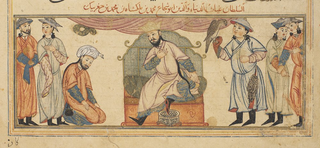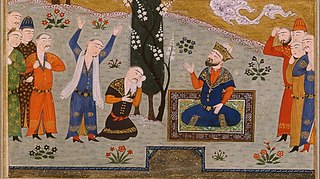This page is based on this
Wikipedia article Text is available under the
CC BY-SA 4.0 license; additional terms may apply.
Images, videos and audio are available under their respective licenses.

Muhammad I was a son of Seljuq Sultan Malik Shah I. In Turkish, Tapar means "he who obtains, finds".

Mazyar, was an Iranian prince from the Qarinvand dynasty, who was the ruler (ispahbadh) of the mountainous region of Tabaristan from 825/6 to 839. For his resistance to the Abbasid Caliphate, Mazyar is considered one of the national heroes of Iran by twentieth-century Iranian nationalist historiography. His name means "protected by the yazata of the moon".
Sharwin I was the fifth ruler of the Bavand dynasty from 772 to 817. He was the son and successor of Surkhab II.
Qarin I, was the eighth ruler of the Bavand dynasty from 839 to 867.
Qarin III, was the ruler of the Bavand dynasty from 1114 to 1117. He was the son and successor of Shahriyar IV.
Yazdagird was the ruler of the Bavand dynasty from 1271 to 1298. He was the cousin and successor of Ali of Tabaristan.
Rustam II, was the twelfth ruler of the Bavand dynasty from 964 to 979. He was the brother and successor of Shahriyar II.

Shahriyar IV, also known as Husam al-Dawla, was the king of the Bavand dynasty of Mazandaran, ruling from 1074 to 1114.
Rustam III, was the ruler of the Bavand dynasty from 1117 to 1118. He was the son and successor of Qarin III.
Ali I, was the ruler of the Bavand dynasty from 1118 to 1142. He was the uncle and successor of Rustam III.
Bahram ibn Shahriyar, was an Iranian prince from the Bavand dynasty.
Quhyar, was the ruler of the Qarinvand dynasty, ruling briefly in 839 until his assassination.
Al-Marzuban, was the thirteenth ruler of the Bavand dynasty from 979 to 986. He was the son and successor of Rustam II. In some sources, his name was changed to Rustam ibn al-Marzuban, which caused confusion among the historians, and made them think that they were two people.
Sharwin III, was the fourteenth ruler of the Bavand dynasty briefly in 986. He was the brother and successor of al-Marzuban.
Rustam V, was the ruler of the Bavand dynasty from 1205 to 1210. He was the son and successor of Ardashir I.

The Qarinvand dynasty, or simply the Karenids, was an Iranian dynasty that ruled in parts of Tabaristan (Mazandaran) in what is now northern Iran from the 550s until the 11th-century. They considered themselves as the inheritors of the Dabuyid dynasty, and were known by their titles of Gilgilan and Ispahbadh. They were descended from Sukhra, a Parthian nobleman from the House of Karen, who was the de facto ruler of the Sasanian Empire from 484 to 493.

Shah Ghazi Rustam, was king of the Bavand dynasty of Mazandaran, ruling from 1142 to 1165. He expanded the borders of the kingdom at the expense of his neighbors, particularly the Ismailis and the Seljuks. He established a Bavandid presence in Gilan as a result of his frequent vengeful raids against the Ismailis, who had assassinated his son and heir, Girdbazu. He also brought Qumis and Ray under Bavandid control during his wars against the Seljuks and the Karakhanids.









